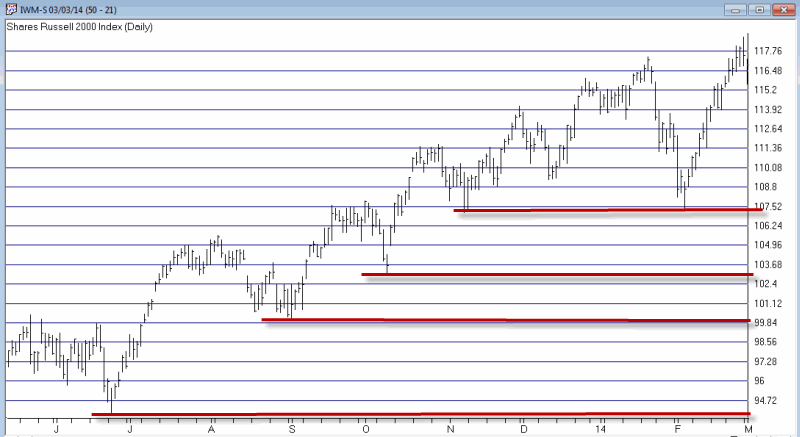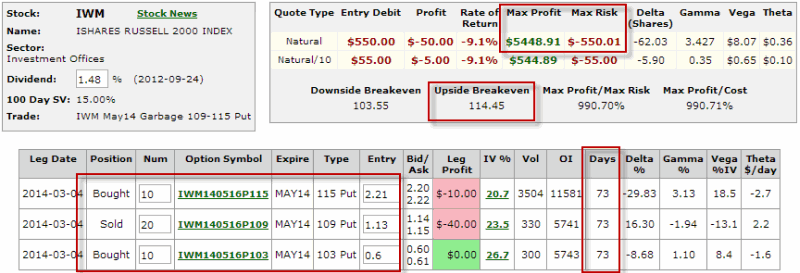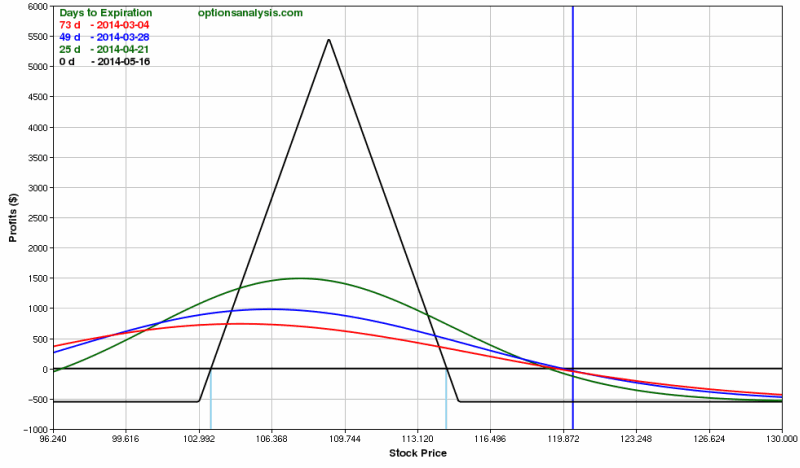So you see what I was talking about, right? Under the category of “I hate it when I’m right”, last week I wrote “when I write an article about a trend that has been playing out time and time again over a several year period – that can pretty much be counted on to put an end to that trend”, referring to the fact that ticker VXX has been in a prolonged downtrend for a number of years.
Within minutes (or so it seems) the Russian Army is on the move. Coincidence?
OK, probably so, but geez, maybe I should try picking tops and bottoms…
Anyway, in light of the newfound fear and loathing that popped back up over the weekend, it is time to review a useful strategy for traders concerned about the downside in the near term.
The Garbage Trade
Several years ago I learned a simple hedging strategy from Gustavo Guzman, a former colleague of mine. He dubbed it the “Garbage Trade”. But don’t be fooled by the name, for it is anything but.
Essentially a hedging strategy, the basic idea of this simple option strategy is to risk a little bit of capital on something that most people don’t think is going to happen. If it doesn’t happen, OK, you lose a little. But if it does happen, you make a whole lot.
One word of warning: for the “average” investor – one whose basic approach to investing is one of “buy a stock or mutual fund or ETF and hope it goes up” – this type of trading is quite a foreign concept. Of course, given the world we live in today, considering alternative ideas to investing and trading might be a good thing.
The Starting Point
The basic idea Guzman taught was that after a market (especially the stock market) had experienced a good run up, a pullback of some sort was invariably due. So his suggestion was after a run up, buy a put option roughly 5% out of the money. Then go down the strike prices until you find a put option that you can sell two of which will pay for the first put option you bought (example to follow). Then if you had gone down say three strike prices from the option you bought to the option you sold, then go down three more strike prices and buy one put at that price.
Right now all of the “non option junkies” have their fingers poised over the arrow to go back to the Main Web Page. But wait!! Please at least consider the example below.
In Figure 1 we see a bar chart for ticker IWM, an ETF that tracks the Russell 2000. Now let’s assume that a trader is concerned about the potential for a pullback – let’s say based on current geopolitical goings on – but not necessarily outright bearish. In other words, he doesn’t want to “Sell Everything!”, but would like some protection if things go south for a while.  Figure 1 – Ticker IWM tracking the Russell 2000 Index (Courtesy: AIQ TradingExpert)
Figure 1 – Ticker IWM tracking the Russell 2000 Index (Courtesy: AIQ TradingExpert)
In Figure 1 we can see that if IWM starts to decline there are several natural “price targets” where a trader might consider taking a profit. But I am getting ahead of myself.
Using Guzman’s outline for the Garbage Trade, one possibility is as follows:
-IWM shares are trading on 3/4/2014 at 120.32.
-If we multiply this by 0.95 we get 114.30
-We can choose either the 114 or the 115 strike price put. Due to higher volume I will select the May 115 put.
-In order to take in enough premium to pay for the 1115 put we would sell 2 May 109 puts for 1.13 each (or $113 x 2 = $226 premium taken in)
-We then go own six more point and buy one May 103 put for 0.60, or $61.
All told, it costs all of $55 to buy a 1 by 2 by 1 position. The risk curves for a 10-lot position costing $550 appears in Figures 2 and 3. Figure 2 – IWM Garbage Trade (Courtesy: www.OptionsAnalysis.com)
Figure 2 – IWM Garbage Trade (Courtesy: www.OptionsAnalysis.com) Figure 3 – IWM Garbage Trade (Courtesy: www.OptionsAnalysis.com)
Figure 3 – IWM Garbage Trade (Courtesy: www.OptionsAnalysis.com)
So basically, one of a couple things will happen. In a nutshell, either IWM will suffer a pullback and this position will offer the potential to make a fairly high return on capital, or the trader stands to lose a maximum of $560.
A couple of things to note:
*If IWM moves to new highs the trader can either:
a. Exit the trade and cut his loss
b. Continue to hold the position – at least for a while – just in case something bad happens later rather than sooner
*If IWM does start to decline then the trader should have a profit target in mind and should pay attention to the price level at which the risk curve for the latest date will “peak” and start to “roll back down.” Figure 1 displays several potentially useful “price target levels” where a trader might consider taking a full or partial profit.
Summary
As always, this example is not presented as a “recommendation”. It is simply an example of one way to get a little exposure to the downside if you start to feel some “concern.”
The vast majority of traders who look to options focus on buying calls and puts in hopes of maximizing a specific market timing method, and/or selling covered calls against stocks they hold. Nothing wrong with these ideas, but the real power of options is that they afford you the opportunity to “attempt” things you normally could not or would not do using stocks, ETFs or futures.
The Garbage Trade is an example of one way to use options to risk small amounts of capital with the potential for significant percentage gains.
As always this example is not a “recommendation”, only an example. Note that it would seem like an illogical time to put on a trade like this. The stock market has bounced back from the Russia/Ukraine crisis in one day and the current trend clearly remains to the upside.
For the record: At exactly the point when the Garbage Trade seems like a waste of money….is exactly the time to consider putting it on.
Jay Kaeppel

